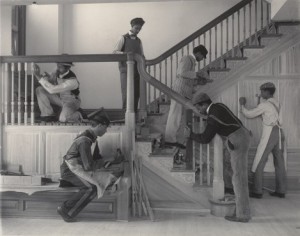
On the very first page of Richard Sennett’s Together this image is printed. Having only read a few pages, I can’t do justice to the text itself and it’s something we’ll need to look at but Tash and I were both drawn to the picture of the staircase as a staged image of co-operation. It’s difficult to articulate why it feels so relevant – the object in the image, still under production is beginning its life as a conveyor, a passage, an elevator, a descender and all hands are committed to different aspects of its manifestation. Alice posted a comment yesterday reminding us of the importance of the object – desks, working spaces and furniture. Can stairs be added to the list?
It is interesting – the process, this process, by which you/we, seem to pick and gather intriguing and relevant (resonant) ideas – where sometimes we barely yet know the whole idea or thesis being delivered in a given text (or artwork, or oeuvre, or field of study) – but we see something that resonates (we notice something). The image you ‘pick up’ of the stairs being made. You know you don’t fully know why it has been included in the book. You have some sense given the book’s title, what you know about the author’s interests/ideas, and what you have surmised from what you have read already. But you don’t know yet the precise reference for this image in relation to this text. I wonder if this process, of half knowing or just beginning to know the context for the selection of an image, idea, quote (reference) is (just) enough and not quite too much of what you need. A kind of suspension between intuiting what it might mean and knowing what it means. A kind of half blindness. I wonder if this is a valuable place for us when we are formulating ideas, and seeking connections to build our own ideas. It reminds me of something Lizzie has written about – ideas sticking to her and staying with her over time. I think this hazy space allows a kind of freedom to make connections and gather in a way that stops when all things are clear, and clearly known (if you yet fully understood). Like we can’t move our tank in the medieval streets (to borrow a metaphor from my partner). I wonder if this is a process that we encourage when working with teachers, part of the permissive space we open up (and they ‘learn’)when entering into a filed that has a density of complex theory and content. It is something that enables a freer movement to allow for personal connections before we get too caught up in what should be known.
The Urge to Move over the Desire to Arrive.
I think you may have rather perfectly re-imagined or re-articulated the urgency behind Huberman’s curiosity curve (which can be found somewhere else on this blog). It seems to me that both ideas recognise the exhilaration of anticipation, a process of becoming that requires motion, a movement from somewhere to somewhere else but which is based on more than the joy of discovery. Is it something to do with how one meets with an idea, tests it against what is already known and makes it ones own? Sating a need for wandering in a non-linear way that deliberately holds arrival at bay. Holding off from consensus in order to allow a space for all of our own curiosities to find some wriggle room for a time. I think for me it is also a way of coming to know a text or idea more meaningfully. When you suggest that the freedom to make connections and gather stops when all things are clear, that’s when Huberman falls off his curve!